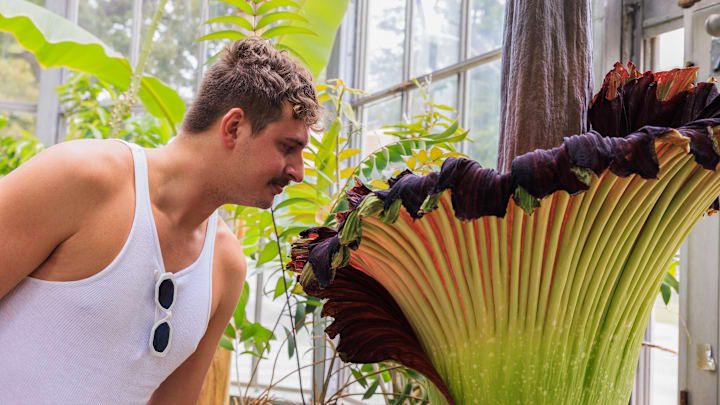Being in the vicinity of a fully-bloomed corpse flower is an experience one is unlikely to forget. In addition to being physically imposing—Amorphophallus titanum can reach heights of 6 to 12 feet depending on the environment—the plant is notable for its noxious stench, which is not unlike that of an open grave filled with rotting flesh. Now, scientists are closer to understanding the chemical process behind this disgusting smell.
In a paper published in the journal PNAS Nexus, researchers at Dartmouth and the University of Missouri paid careful attention to A. titanum once it began blooming, a process that transpires every several years. (The Dartmouth plant was examined in 2016 and again in 2022.) One sign of the impending bloom and ensuing odor is increased temperature of the plant’s central stalk (or spadix), which can rise 20 degrees above its surroundings.
During this process, the team took samples they could use for RNA sequencing as well as analysis. As the flower bloomed, it manufactured both methionine—a kind of building block for smelly compounds like dimethyl disulfide and dimethyl trisulfide—as well as putrescine, the same chemical found in rotting flesh.
Why would a plant need to smell like a broken meat locker? The corpse flower isn’t really concerned with repelling humans as much as it is attracting insects like dung beetles for pollination. That’s the evolutionary reason for its putrid aroma.
Italian botanist Odoardo Beccari is believed to have discovered the flower while exploring the Indonesian island Sumatra in 1878. It quickly became infamous upon its arrival in Europe, both for its smell—which was said to have sickened an artist charged with painting it for posterity—and its undeniably phallic presentation. (Hence the phallus in its name.)
While many people would want to avoid a corpse flower in full bloom, others feel the need to satiate their curiosity about just how bad it reeks. In 2021, a nursery in Alameda, California, brought a corpse flower in all its vile glory to a gas station so the general public could get a whiff. More than 1200 people showed up.
More recently, Guardian reporter Henry Belot visited a blooming specimen at Geelong’s botanical garden in Australia. The smell, he wrote, “hits you like a punch in the face.” Visitors compared it to “dirty socks” and “warmed-up road kill,” among other delicacies.
